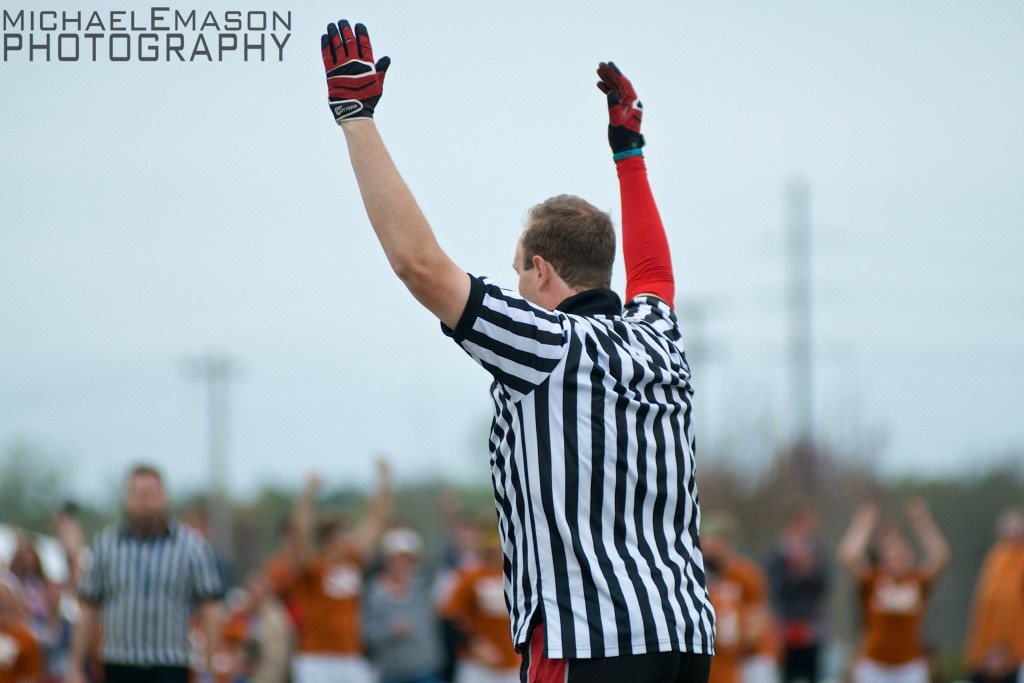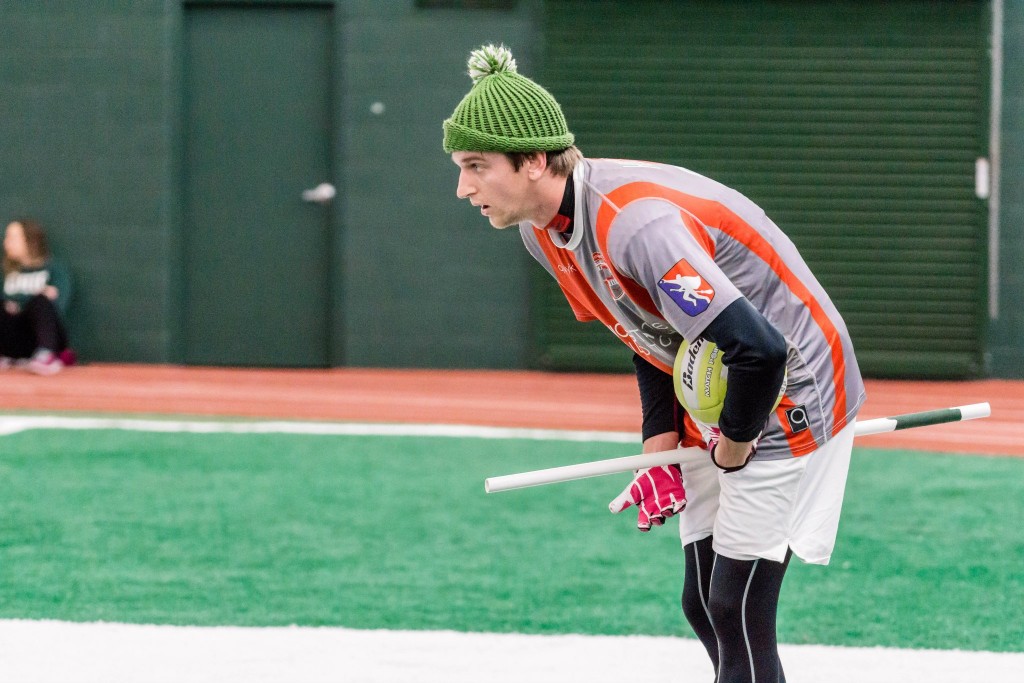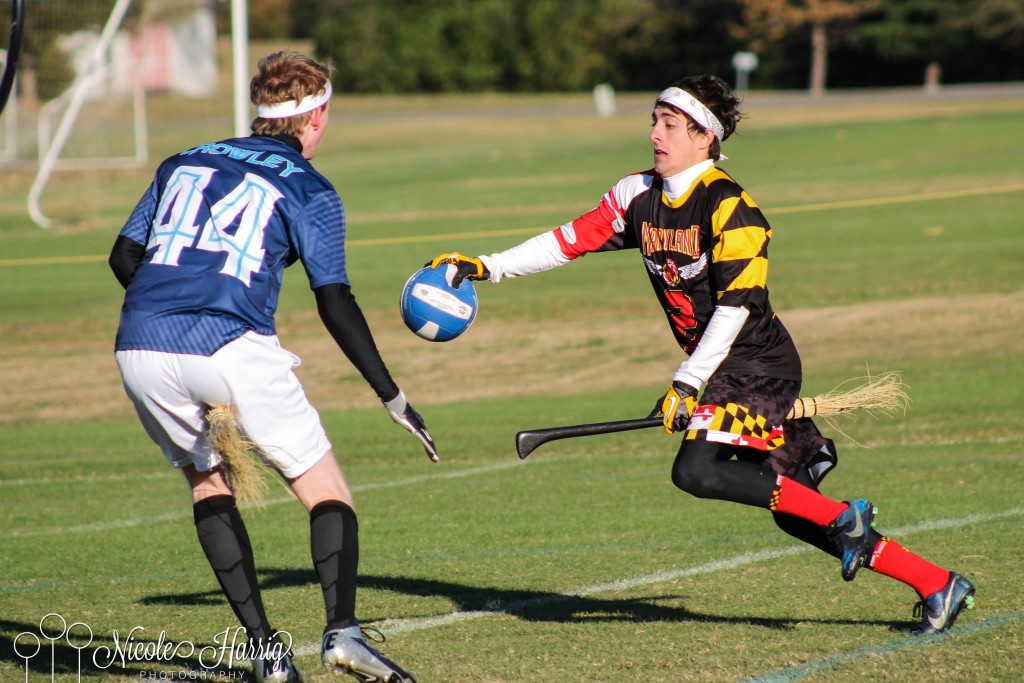- Rule, Britannia, no more?
- Unpopular Opinions: US Quadball Cup 2023
- Proven Contenders: University of Virginia
- Proven Contenders: Rutgers University
- Proven Contenders: University of Michigan
- Proven Contenders: Creighton University
- Different Perspectives: A Look Inside USA Ultimate
- Antwerp QC, Much of Belgian Core, Leaves Competitive Quidditch
Unpopular Opinions: World Cup 8

Credit: Michael E. Mason
Welcome to the third annual edition of The Eighth Man World Cup Unpopular Opinions! We’ve had a pretty good run of form over the past two years, including a 6-for-9 posting last season that would have looked even more impressive if Kevin Oelze hadn’t hedged on his wording of the NYDC Capitalists’ eventual fate. So, let’s see if we can keep the luck going. As always, the following are a series of predictions for World Cup 8 that go against the grain of public opinion. Let’s get right to it.
The Midwest Will Not Advance a Team Past the Sweet 16
By Devin Sandon
The Midwest Region entered our first media poll this year with five teams in the Top 20, with the highest, Ohio State University, coming in at No. 8. As the season progressed, the Midwest continued to have either four or five teams in the Top 20, and the flagship program, Ohio State, rose to No. 6 before eventually dropping down to No. 8. Similarly, the USQ standings have four Midwest teams in the Top 20, with Ohio State ranked No. 4.
At the last three World Cups, the Midwest has, by year, advanced one team to the Final Four (University of Minnesota) at World Cup V, advanced one team to the Final Four (Bowling Green State University) at World Cup VI and advanced one team to the Elite Eight (Ohio State) at World Cup VI. Given the region’s history—and given that we have ranked four Midwest teams in our Top 20—the prediction that not a single team will advance more than a single round in the bracket seems wholly contrary to reason.
And yet, I say again, no Midwest team will advance past the Sweet 16. To make this argument, I must in essence demonstrate that none of the top Midwest teams will achieve what many expect of them. The four teams I will examine are: Ohio State, the University of Michigan, the University of Kansas, and Bowling Green. They are four programs with immaculate histories, strong records, high expectations and, I would argue, fundamental flaws.
First, Bowling Green. The Falcons boast a 21-7 record and the No. 12 spot in our media poll. They have enjoyed a history of success in highly competitive tournaments, finishing in the finals of their last two regional championships and having reached the Final Four of World Cup VI. However, all is not well with Bowling Green. They have played four official games this spring, finishing 2-2, with a SWIM situation win over Michigan State University, a SWIM situation loss to the University of Michigan, an out-of-range loss to Michigan and a clean victory over Grand Valley State University.
The first concern is one that I cannot raise with the scores alone. When Bowling Green played Michigan State, its offense was sloppy. The team forced plays, attempted overly long passes and failed to finish when the opportunity arose. Its beaters also made some odd decisions, exposing the squad to fast breaks from the Spartans, whose failure was often more a testament to Michigan State’s inability to finish or luck than any great defensive effort. For Bowling Green to succeed, the Falcons need their passes to be intelligently made, crisp and on target, as well as improve their communication. In the face of rostering problems for Bowling Green coming into cup, these necessary corrections seem unlikely to occur to such a degree that would allow this team to slip into the Elite Eight again.
Second, University of Kansas. Kansas has widely fallen out of the public perception, and in some senses this is for good reason. Kansas has played only a single game since its regional in November: a match against its B-team to fulfill World Cup requirements. In the fall, Kansas showed troubling vulnerability at times, winning 90*-60 over No. 79 Oklahoma Baptist University. Combined with lack of competitive play for five months, Kansas seems ripe to be upset and to face an early exit unbefitting their standing. That said, if I had to bet on one of these four teams to make a deep run, it would be Kansas. The squad always looks vulnerable in the fall, but really shows up in the spring. This is a very intelligent team that can leverage its skill sets to be a threat to teams that are fundamentally better than it on a number of levels. While I don’t think Kansas will make the Sweet 16, I do think it is a bit of a dark horse.
Third, Michigan. Michigan has seemed quite ascendant, scoring decisive out-of-range wins over Bowling Green and Blue Mountain Quidditch Club, although the Wolverines displayed both vulnerability and incredible drive in an 80*-70 win over University of Rochester. The fact that Michigan achieved all of this with a very short roster makes it even more impressive. The question is, can Michigan’s full roster fill the gaps that were shown? Michigan is a team whose beaters excel at getting and holding bludger control so its chasers can dominate a pitch with their sheer physicality. To do this, the Wolverines tend to play very conservatively to maintain control, which frequently exposes them to long shots. The two difficulties Michigan will face, as a result, is teams that have strong beaters and the capacity to make shots from distance or teams who can match its chasers’ physicality. Unfortunately for Michigan, the vast majority of the top teams fall into either one category or the other. Michigan could slip through to the Elite Eight with the right matchup, but it’s more likely that the Wolverines will run into a team that can play to their weaknesses first.

Credit: Jessica Jiamin Lang
Finally, Ohio State. This is the team which every metric we have says should make the Elite Eight, so how can I be resolute in the claim that it will not? Well, first, Ohio State hasn’t played a single official competitive game with a realistic roster since its regional tournament in November. Despite attempts to the contrary, bad weather and inclement field conditions have denied Ohio State the opportunity to play. Five months without competition hurts. Beyond that, this team has struggled with injuries this spring. The Buckeyes were forced to drop out of an unofficial tournament hosted by Ohio University due to injuries. Hopefully these injuries won’t have impacts on their World Cup roster, but having players out for any period of time is likely to hurt preparation to some degree. The final concern is this: Ohio State built up a reputation in the fall for being a beautiful passing team, but I think some of what the Buckeyes were is lost in the phrase. They are not World Cup VI UCLA, nor are they World Cup VII Boston University. They are not a team in which every player on the field can act as a playmaker and work the ball seamlessly to, in and around the hoops until an opening materializes. Ohio State is a team with a couple of very good playmakers who set up plays for their teammates to finish. Against good defenses—and any team you encounter in the Sweet 16 is likely to have one, except perhaps UNC—a one-pass offense is liable to struggle. You need to have more ball movement to expose a weakness, aggressive beaters to create pressure or a dangerous driver to force a defense to overreact. Ohio State has many things, but it doesn’t really have any of those. The Buckeyes are an undeniably good team, but unless they are able to shake the rust accumulated over a long winter, they could be in for a rough time at Rock Hill.
The Swiss Format Will Be Seen by Most as a Success
By Kevin Oelze
I’m doubling down here on a system I feel pretty strongly about, but I do believe that most people will ultimately judge the change to Swiss as a positive move.
When Swiss was first revealed, it had a couple of problems, but the biggest one was that the marketing of it made it seem like it was a system designed so that the bottom-tier teams at World Cup could actually have something that made it worth going, which, without getting into a lecture, wasn’t.
The only thing the quidditch community hates more than things staying the same is things changing, and it’s understandable that top teams are less than thrilled with losing their Saturday cakewalks. But ultimately, I feel like this is going to give us a more balanced bracket with more accurate seeding, and we’ll see fewer large disparities in schedules.
Last year, most of the top teams didn’t play a meaningful game until the Sweet 16, and seeds from the middle-tier teams were really determined by luck of the draw. I’m not sure this will change a ton for the top-tier elite teams, who will likely coast to 4-1 or 5-0 records with one difficult game, but we’ll see much better rankings and no teams sneaking into the bracket that don’t deserve to be there. This should greatly improve the quality of the bracket games in general, and likely give us some very solid round of 24 games, and not games reminiscent of the 150*-20 massacre Baylor University gave the University of Ottawa Geegees in the Round of 32 last year. And unlike last year, the pool play games between the top teams will be must-watch affairs instead of predetermined stomps. Every game will matter this year, and ultimately, people will accept that as a good thing.
Two Regions Won’t Put a Single Team Into Bracket Play
By Devin Sandon
It’s not a particularly bold statement at this point to think it likely that the Northwest will fail to advance a team to the bracket. The region is sending only two teams this year: The University of British Columbia and Western Washington University. Neither team has played a single game outside of its region, and despite the advantages of strong seeds due in part to an inflated strength of schedule metric due to isolation, both teams will be in the fight of their lives to win even their first matchup against relatively weak opponents.
The claim that a second region will fail to advance a team is the far bolder part of this statement, and, consequently, I’ll spend the majority of my time defending it.
I believe that odds are better than even that the South will not advance a team to the bracket. World Cup qualifying teams from the South played 19 games against World Cup qualified opponents outside of the South this season. In those games they were 1-18, with the lone victory being a University of Miami win over the 3-16, No. 106 Austin Quidditch.
Now, such a claim, supported by only that evidence, must be taken with a grain of salt. The South’s standard bearer, Florida’s Finest Quidditch Club, carries an impressive 20-1 record, with no losses to non-regional opponents. However, the region’s general performance begs the question of how much weight we can assign to its winning ways. Florida’s Finest has played four snitch-range games so far this season:
(25) University of Miami 90^ – 60 Florida’s Finest QC (9)
(9) Florida’s Finest QC 120* – 90 University of Miami (25)
(9) Florida’s Finest QC 90* – College of Charleston 80 (66)
(9) Florida’s Finest QC 120* – 70 Tennessee Technological University (46)
While these results are interesting in and of themselves, what makes them far more so is the fact that each of these opponents has played teams from outside the region, so we can see how their scores stack up between Florida’s Finest and other qualifying teams.
(25) University of Miami 160*-50 Austin Quidditch (106)
(47) Loyola University-New Orleans 110*-100 University of Miami (25)
(47) Loyola University-New Orleans 130*-100 Miami (25)
(7) Texas State University 110 – 70* University of Miami (25)
(8) UNC 130-70* College of Charleston (66)
(8) UNC 160-80* College of Charleston (66)
(8) UNC 140-80* College of Charleston (66)
(39) Appalachian Apparators 180*-50 College of Charleston (66)
(39) Appalachian Apparators 140*-40 College of Charleston (66)
(14) Bowling Green State University 110^-60* Tennessee Technological University (66)
(45) Miami University of Ohio 90*-50 Tennessee Technological University (46)
(21) Ball State University 120*-90 Tennessee Technological University (46)
What we see from these results is that, by and large, the Flamingos’ results against these opponents do not much match those of the teams that have been regarded as similar to them all season. In fact, in some cases, their results more closely resemble those of teams falling in the 30s and 40s of the USQ rankings. While this analysis doesn’t examine Florida’s Finest’s three out-of-range victories over these South rivals, it does provide a reason for caution. Florida’s Finest has not faced a team polling in the Top 20 of our latest media poll, and easy opposition leads to stagnation. The team does not practice with any real frequency and has not been forced to adapt or develop this season. While its more than possible that they’ll make bracket and look like the team that made the Sweet 16 last year, my bet is that they won’t.
Ohio State Will Choke
By Luke Changet
In the fall, Ohio State was far and away the best team in the Midwest. If you look at official results, there is not much to say that the Buckeyes are not still the best team in the Midwest. But if you look closer, you will see that all of those results are from the fall. This is a team that has not played an official game of quidditch since regionals. In November. It has also not had a full roster since then. The Buckeyes’ largest turnout was at Glass City, and that was with only 13 people, half of whom play for the Mighty Bucks, Ohio State’s B-team. Ohio State peaked in the spring, and unless it has been doing something crazy behind the scenes, there is no way it will go farther than the Sweet 16, if that far at all.
Yes, this is still a team full of incredible players, but not being in action for five months takes you out of the game a bit. As firm of a believer I am in the Buckeyes’ talents and abilities, I do not think that they will be able to perform at the same level they did in the Fall, and that will cost them dearly. They won’t get beyond the Sweet 16, and their odds of even getting there are looking like little more than a coin flip.
Maryland Will Make the Final Four
By Ethan Sturm
I’m pretty sure I’ve made this feeling very clear over the past few weeks, but with the amount I’ve written and podcasted over the past month, it’s hard to come up with completely novel ideas. So instead, I will spend a little time defending this one.
Somehow, University of Maryland has gotten a bad rap this season, and not just for dirty play or bad sportsmanship. Despite starting the season ranked No. 3 in our polls, the team more or less steadily fell all year—getting as low as No. 8—despite losing only one game. This team is 25-1, including an incredibly impressive 6-1 against the rest of the Top 20.

Credit: Nicole Harrig
So how did the Terrapins drop? Well, mainly, because two of the most-viewed films of them this season have been two of their worst games: their loss against Tufts University and their overtime thriller against UNC. But the former came against a Jumbos squad that had already played them once that day and simply could not miss in the finals, while the latter was on an icy November night in Virginia, a far cry from the mid-70s of this weekend in Rock Hill. Make no mistake: This is very much the team that earned the No. 3 spot in our rankings at the beginning of the season.
It’s also very much a team built to succeed at a World Cup like this. The advantage we have been giving to Lone Star Quidditch Club all season—the incredible depth to survive Swiss play—is an advantage the Terrapins can apply as well. Don’t forget that last season’s team, which made the Sweet 16 and gave eventual champions one hell of a game—was missing both Harry Greenhouse, Sam Gaffigan and Matt Angelico, and that this team is almost identical personnel-wise.
The squad also has many of the characteristics for a deep bracket run. It can make open-field, score-stopping tackles, it can rotate players and it has a seeker game that is 7-0 in SWIM situations on the season. Sure, the Terrapins played some games that have been closer than they should be, and they lost to Harvard University at last year’s World Cup, but I will point you again to that 6-1 record against the Top 20 and the fact that Texas State lost to Macaulay Honors College at World Cup before making its championship run.
Picking an exact Final Four is almost always going to be an exercise in futility, based heavily on the bracket draw, injuries and third-party factors such as referees and snitches. But Maryland is a team built in the image of the Texas teams that have found so much success in recent seasons, and if there’s a team I have to get behind outside of those four to make a deep run, I’ll be flying my red, black, yellow and white (god that’s an unnecessary number of colors) flag.
Lower-Tier Southwest Teams Will Be Tough Outs, But Cause Few Major Upsets
By Devin Sandon
While it’s widely understood that the Southwest has some of the strongest teams in the world, the seemingly related notion that the bottom of the Southwest can compete with the mid- and upper-tier teams of other regions will not prove to be correct. The working theory is that lower-tier Southwest teams will be an upset threat because they will be able to use an extremely physical defense to keep scores close enough to allow them to make a pull and win. To see how this shows up in reality, I’ll take a look at several Southwest teams that have played opponents from the Midwest and see how they have matched up.
For the purpose of comparison, I will seed each team by where it ranks in its own region. The Midwest was chosen because there is a decent amount of data, and it is a deep enough region for the comparison to work, as seeing how the No. 12 team from the South faired against the No. 14 squad in the Southwest for example probably wouldn’t tell us much. The Southwest team in each matchup will be bolded.
(13) Tribe 170*-60 TC Frost (20)
(13) Tribe 110*-90 University of Missouri (10)
(6) University of Minnesota 180*-80 Tribe (13)
(15) Oklahoma Baptist University 110-70* Crimson Warhawks (17)
(2) University of Kansas 90*-60 Oklahoma Baptist University (15)
(6) University of Minnesota 130-70* Oklahoma Baptist University (15)
(2) University of Kansas 140* – 60 Oklahoma Baptist University (15)
(10) University of Missouri 180*-90 Oklahoma Baptist University (15)
(15) Oklahoma Baptist University 100*-70 University of Missouri (10)
(6) Oklahoma State University 120*-70 University of Minnesota (6)
(2) University of Kansas 110*-30 Oklahoma State University (6)
(6) University of Minnesota 130*-30 Oklahoma State University (6)
(6) Oklahoma State University 170*-50 University of Missouri (10)
(6) Oklahoma State University 100*-50 University of Missouri (10)
(6) Oklahoma State University 160*-40 Crimson Warhawks (17)
(6) Oklahoma State University 150*-60 Crimson Warhawks (17)
(6) Oklahoma State University 170*-90 University of Missouri (10)
(5) University of Arkansas 60*-50 University of Missouri (10)
(2) University of Kansas 130*-60 University of Arkansas (5)
(6) University of Minnesota 100*-40 University of Arkansas (5)
(5) University of Arkansas 120*-30 Crimson Warhawks (17)
(5) University of Arkansas 80*-50 University of Kansas (2)
(5) University of Arkansas 160^-120 University of Missouri (10)
What the scores show is that the team you would expect to win, based on where they stand within their region, tended to win. In the 23 games, there were four upsets, three in favor of the Southwest team and one in favor of the Midwest team. The largest upset was a No. 15 beating a No. 10. When teams had the same seed, they were split with one win for the Midwest and one for the Southwest. Given all of this, we can say that upsets are most likely to occur when teams are within five seeds of each other. While it does appear that Southwest teams may punch a bit above their weight, there is little in the data to support a reasonable expectation that we might see the Osos De Muerte best QC Boston: the Massacre, or Clone Star Quidditch Club over the Lost Boys Quidditch Club on Saturday morning, or that we might see any particularly startling upsets coming from the Southwest’s lower tier throughout the tournament.



